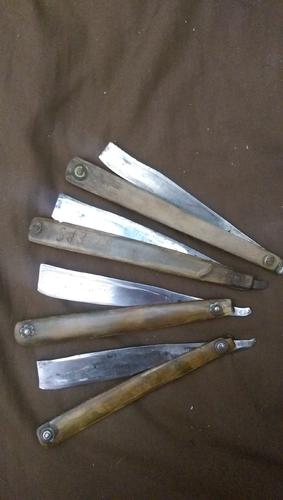Results 11 to 15 of 15
-
05-10-2014, 02:36 AM #11

James Hallam, Mary Hallam also used "Paris" mark.
 Alex Ts.
Alex Ts.
-
The Following 3 Users Say Thank You to manah For This Useful Post:
pfries (05-10-2014), Wolfpack34 (05-10-2014), Wullie (05-11-2014)
-
05-10-2014, 03:54 AM #12

Do you think there were originally extra marks on this one? Given there were varied Paris stamps in existence.
Also noted is the hollow in the spine near the toe - Lummus talks of this being stylistic of earlier razors; to me this seems to generally be the case.
edit: now that I've got my camera, here are more examples of that dip in the spine.

Last edited by ScienceGuy; 05-10-2014 at 04:17 AM.
-
The Following User Says Thank You to ScienceGuy For This Useful Post:
Ullmencott (05-10-2014)
-
05-10-2014, 05:22 AM #13

It has a significant dip near the toe as you described. And there is no sign of any other markings.
It looks like the one in the bottom on your picture. It also have the same cut at the pivot end of the scales.
-
05-10-2014, 06:39 AM #14

I also saw that on mine

During the first empire, french razors had the same style of "decoration" near the nose.
An exemple from a pair owned by a friend of mine.

(for sale, by the way)
-
05-10-2014, 06:37 PM #15

Good catch Manah!
That was staring right at me from the opposing page.
Interestingly, James Hallam was only listed as a lancet and phleam manufacturer in the 1774 Gales & Martin. Apparently he expanded his business by the 1780's!
That said, based on the stamp, I think Paris Justice is slightly more likely. If it is a partial stamp, there would have been room for Hallam's full mark, but not Justice's. Still, it might actually be someone altogether different.-Zak Jarvis. Writer. Artist. Bon vivant.


 37Likes
37Likes LinkBack URL
LinkBack URL About LinkBacks
About LinkBacks







 Reply With Quote
Reply With Quote
